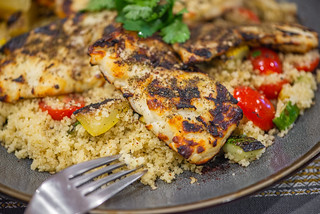Caprese Tortillas a la Parilla
When I first saw that large stuffed tortillas were a thing in Northern Argentina and decided I wanted to try my hand at making them, I naturally gravitated to the most common filling of ham and cheese. But once I had my traditional basis covered, I felt free to experiment with any manner of ingredients I felt drawn to. I let a need for a vegetarian version of this dish become my first guide point, and the abundance of basil and the first ripe tomatoes of the season at the farmer's market became the second that lead me to these caprese tortillas a la parilla.
Like when making pastry, the dough for these tortillas is heavily butter and flour, with just enough water added to form a cohesive mass. Unlike pastry though, the butter is first melted and then incorporated into the flour, and once a dough ball has formed, the entire thing is kneaded until smooth. The kneading helps form gluten, which later is what makes it easier to roll out this dough thinner than I usually would with a pastry dough.
A few years ago I filled my herb garden with sweet Italian basil and found a need to become adept at making pesto because it was the best way I could figure out to use up and elongate my basil crop. I have come to prefer the silkiness of pesto made in a mortar in pestle, but I went the easy route on this particular day and utilized the food processor to first chop all the basil, garlic, and pine nuts, then formed the sauce by drizzling in extra-virgin olive oil until the consistency was correct. A bit of parmesan then went in at the end, which provided the salty and savory depth to complete the sauce.
After resting the dough in the fridge, I divided it in four and rolled out one piece to roughly 1/8-inch thick. I then placed a couple slices of low-moisture mozzarella on half of the dough and set a couple slices of tomato on top of those. I spooned on some pesto next, followed by a drizzle of balsamic glaze. I was worried the tomatoes and pesto would introduce too much moisture and make the dough soggy at top, so I opted to add another slice of mozzarella as moisture barrier.
Once all the stuffing ingredients were arranged, I folded over the empty side of the dough and pressed the edges together to create a tight seal. Since this was basically just a giant empanada, I used the same pinch and tuck method to further seal the edges and also create an attractive crimp.
To get a fully cooked dough, melted cheese, and not an overly scorched exterior, I found a two-step cooking method worked best. First, I placed the tortillas close to, but not directly over, a two-zone fire where the coals were situated on one side of the charcoal grate. I let the dough cook there, covered, until it released easily from the grates, at which time I flipped, covered, and waited for the same thing to happen with the second side.
By the time this was done, the dough was more-or-less cooked and I mostly just needed to get color on the outside and did this by sliding the tortilla over to the hot side of grill and letting it cook until it browned and charred in spots. I flipped it pretty often at this point so I could keep a good eye on the progress and avoid over blackening—since the exterior is dry by now, it browns and blackens pretty quickly.
I found a lot of comfort in the ham and cheese version of these tortillas, but the caprese variation was a lot better in my opinion. I mean, we all know this mixture of ingredients works well, and I had done a very similar panini in the past that my friends all loved, so it's not like this was a hard sell or something new or novel. Still, it's not until I actually bit into one of these tortillas that I fully remembered how good the caprese combo is, especially with sweet and super juicy in-season tomatoes and bright, herbal pesto. I can't say whether or not that additional piece of cheese was required for moisture control because I didn't make any tortillas without it, but all of mine cooked up perfectly and I didn't feel like there was too much cheese, if anything, I'd have been happy with even more. So now that I've got one very traditional and another simple incarnation of these Argentinian tortillas in my recipe bank, I feel like my next stop is going to be something out of left field to see how they hold up to some of my more out-there ideas.










